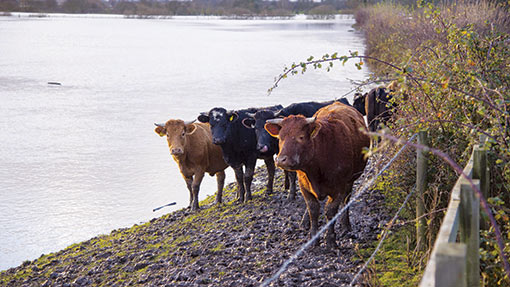Grass silage contamination warning for flood-hit livestock farmers

Livestock farmers who have been affected by flooding can take a variety of actions to limit the effect of floodwater on this year’s grass silage.
“In the worst-hit areas there will sadly be those who won’t even have a crop of grass available for first-cut foraging,” says independent silage specialist David Davies of Silage Solutions. “And because the flooding has been so extensive, there will be many others who are dealing with flooding for the first time.”
See also Grassland management tips in the wet weather
For those with a salvageable crop, he says a high priority is to remove contamination from the sward with some urgency by either cutting or grazing as soon as weather and ground conditions allow.
“The residual grass from last autumn will be coated with a layer of silt, and the extent of the damage this will cause will depend on the degree of contamination,” he says.
“Depending on the floodwater’s origins, there are likely to be higher levels of clostridia – which will potentially cause poor silage fermentation and nutritional losses by producing butyric acid and breaking down protein into ammonia – and possibly also higher yeast populations.
“And despite the potential for fresh rainwater to wash away some of the contamination, clostridia spores in particular are able to persist on the crop.”
An early cut or graze to remove residual material prior to closing fields for first-cut growth will have the added benefit of removing dead material, which will be particularly prevalent if too much residual sward was left last autumn.
Those missing out on first cut who go for a later, bulkier crop are also likely to have increased stem and dead material, which will make the exclusion of air more difficult, leaving the way for yeasts and moulds to cause spoilage and further nutrient losses.
“This is why good clamp management will be more important than ever for many farmers this year,” continues Dr Davies.
It means evenly spreading forage in layers of 6-9in thick, compacting each layer, using side sheets as well as sheeting the top to make a good seal, and weighing down the forage as soon as possible after sealing.
“In perfect grass-growing and silage-making conditions, this should be enough,” says Dr Davies. “But wherever conditions have been difficult, I’d recommend using an additive that’s been proven to eliminate the key aerobic spoilage organisms.
“Check product labels and look out for sodium nitrite, which will kill damaging clostridia and other harmful bacteria, and sodium benzoate and potassium sorbate, which are currently the only commonly used preservatives proven to eliminate yeast activity without compromising fermentation and which are used as ingredients in a range of additives,” he says.
“If the correct actions are taken, there’s no reason why the livestock farmer facing difficult conditions can’t continue to make good-quality forage.”
